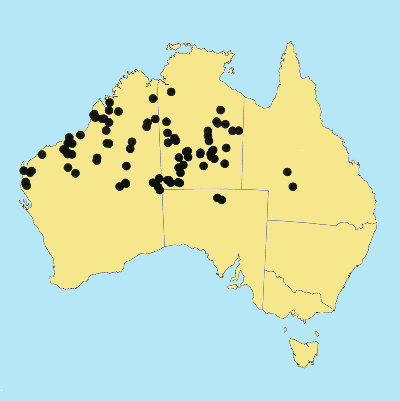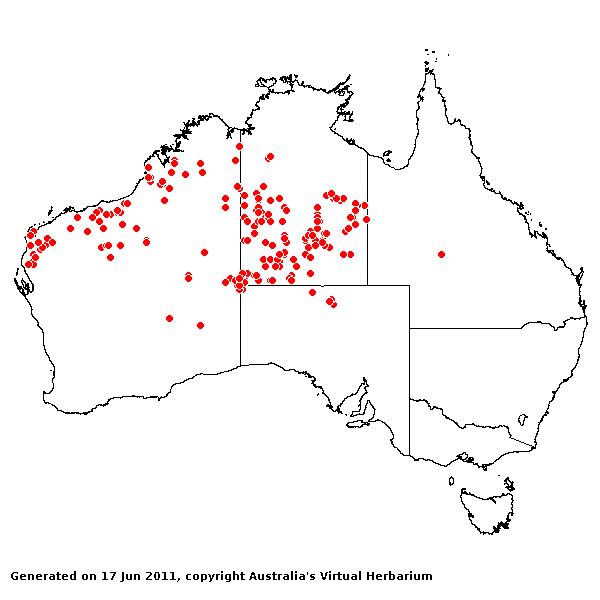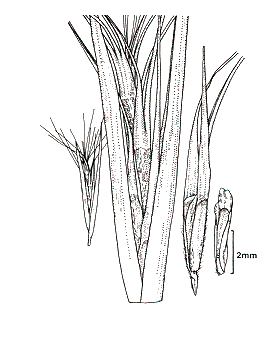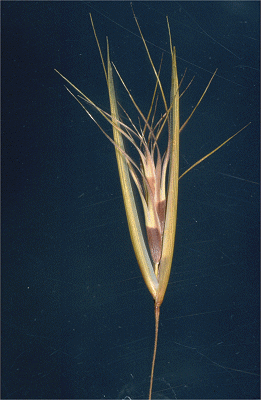Triodia schinzii (Henrard) M.
Lazarides. Austral. Syst. Bot., 10(3): 474 (1997).
Classification. (GPWG 2001) : Subfamily Chloridoideae. Triodeae.
Basionym and/or
Replacement Name: Plectrachne
schinzii Henrard, Vierteljahrsschr. Naturf. Ges. Zurich 74: 134
(1929).
Type of Basionym or
Protologue Information: HT: G.F. Hill 344, 14 Jun 1911, Australia:
Northern Territory (Z; IT: US-1061245).
Key references
(books and floras): [1952] C.A.Gardner, Flora of Western Australia 1
Gramineae (82 as Plectrachne), [2002] D.Sharp & B.K.Simon, AusGrass,
Grasses of Australia, [2006] J.Jessop, G.R.M.Dashorst, F.M.James, Grasses
of South Australia (418).
Illustrations:
[2005] K.Mallet (ed.), Flora of Australia 44B: Poaceae 3 (Fig.
37M-P), [2006] J.Jessop, G.R.M.Dashorst, F.M.James, Grasses of South
Australia (418, fig. 349), [1984]
N.T.Burbidge. rev. S.W.L.Jacobs, Australian Grasses (217 as Plectrachne schinzii).
Habit.
Perennial. Culms erect, 10–210 cm tall, 2–6 -noded. Mid-culm internodes
glabrous. Mid-culm nodes glabrous. Lateral branches branched. Leaf-sheath
auricles absent. Ligule a fringe of hairs. Leaf-blades aciculate, conduplicate,
9–25 cm long, 0.8–2 mm wide. Leaf-blade surface glabrous.
Inflorescence.
Inflorescence compound, a panicle. Panicle linear or lanceolate or oblong,
10–19 cm long, 2.5–3 cm wide.
Spikelets.
Spikelets pedicelled. Fertile spikelets many flowered, with at least 2 fertile
florets (2–4), comprising 2–4 fertile floret(s), with diminished florets at the
apex, linear or lanceolate, laterally compressed, 10–30 mm long.
Glumes.
Glumes similar, shiny. Lower glume linear or lanceolate, membranous or
scarious, keeled, 1-keeled, 7–11 -nerved. Lower glume surface glabrous. Lower
glume apex mucronate or awned. Upper glume linear or lanceolate, 12–32 mm long,
membranous or scarious, keeled, 1-keeled, 7–11 -nerved. Upper glume surface
glabrous. Upper glume apex entire, mucronate or awned.
Florets.
Fertile lemma 7–8.5 mm long, without keel, 3 -nerved. Lemma surface glabrous or
indumented. Lemma apex lobed, awned, 3 -awned. Median (principal) awn 20–25 mm
long overall. Lateral lemma awns present. Palea 2 -nerved. Lodicules present.
Anthers 3.
Continental
Distribution: Australasia.
Australian Distribution:
Western Australia, Northern Territory, South Australia, Queensland.
Western Australia:
Hall, Dampier. Canning, Carnegie, Giles, Helms, Fortescue, Carnarvon. Northern
Territory: Victoria River, Barkly Tableland, Central Australia North,
Central Australia South. South Australia: North-western, Lake Eyre. Queensland:
Mitchell.
Notes.
Distinguished by the extremely long, many-nerved glumes much longer than the
body of the spikelet; transverse thickened line on lemma body well below sinus
of lobes; bitextured, usually glabrous palea usually shorter than lemma body;
appressed pubescence on lemma; long-bearded orifice; slender, usually pungent
callus.
Between
lats. 16° and 29°S in W.A., southern part of the N.T., and the L. Eyre and
North-West Regions of S.A. Recorded for Qld by Jacobs (1992), but no specimens
seen. Chiefly on plains, dunes, sandhills, swales and pindan in deep, red
sands, sandy loams, clayey sands and sandy red earths; also on alluvial creek
levees, coastal pindan and beach sands; associated with sandstone, laterite,
limestone and slates; flowers Jan.-Oct.; fruits Jan.-Oct.





